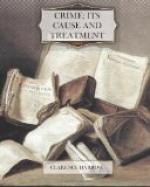The origin and development of all animal life is the same. In fact, the development of plant life is on a similar pattern. The origin of a human being is a simple cell, an egg. This cell is fertilized and through growth after fertilization begins dividing and building and taking on the form and semblance of a human being. All children have the same origin, the same development and the same pattern, yet no two are alike. Each has a distinct and different equipment from any of the others. The size of the body, real and potential; the size and fineness of the brain; the delicacy and sensitiveness of the nervous system; the innate instincts upon which conduct mainly rests; the emotions which control action and which flow from the structure—in short, the degree of perfection and imperfection of the machine is all hidden in the original cell. No well-informed person now thinks of questioning the fact that the main characteristics of the human being, as of every other animal and plant, are hidden in the germ or seed from which it sprang.
The laws of growth and development which govern organic matter were not made for man and do not except man. Life begins with the cell and evolves according to pattern. If the cell is that of a human being, it will be black or white, male or female, tall or short, intelligent or stupid, sensitive or stolid; it will develop a large or a small brain, a fine one or a poor one, a sensitive nervous system or a defective one; it will be ruled by instincts that are all-powerful and controlling, and even the color of the hair and eyes are in the pattern. The whole structure, potentially, is in the original cell, and infinite knowledge could tell how the structure would respond to sensations as it passed through life.
It is obvious that the kinds and differences of human structures are infinite. It is no more possible for all men to respond equally to the same stimulus, than it is for all machines or all animals to respond alike. It is apparent that not one of the structures can ever work perfectly, and that from the best down to the poorest structures are infinite degrees of perfection, even down to the machine that has no capacity for any kind of work.
No ordinarily intelligent farmer doubts for a moment that all of this is true in the breeding of stock. He would never expect the same results from various breeds of cattle or even from all cattle of the same breed.
There is no exception to the rule that the whole life, with every tendency, is potential in the original cell. An acorn will invariably produce an oak tree. It can produce no other tree, and it will always develop true to its own pattern. The tree may be larger or smaller, more or less symmetrical, stronger or weaker, but always true to the general pattern of the oak. Variations will be certain, due in part to heredity and in part to environment.




